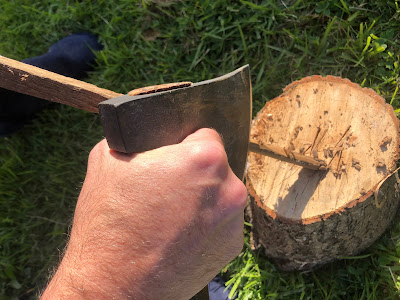I even had a cast iron wood-stove I was restoring. I had seen portable wood stoves for ages and even camped near some on occasion and thought they would suit my projected need quite nicely. Bigger than a backpack pot-stove but not as big as one of my kettle BBQ's or the cast iron one. I wanted something I could use to burn household and reclaimed timber if needs be, more so than logs and branches that an open-fire pit might be used for. Portability was also an important consideration.
 It seems the particular model I chose is out of production and the current models are square sided, rather than rounded, but this plays very little part in its utility as a camp-stove.
It seems the particular model I chose is out of production and the current models are square sided, rather than rounded, but this plays very little part in its utility as a camp-stove. The legs, once unfolded, are held in place by those same retaining pins as used for storage. The rigid stove-pipe sections are easily fitted to the stove-body, which features a small section proud of the cook-top for ease of mounting. Its worth noting that one section of pipe features a flue control valve, just a simple spinning disk on a rod that can be angled to choke down the fire as needed. The five stove-pipe sections do not feature a spark arrestor, or an end-cap, but it has been easy enough to make one with a re-purposed soup-can and a couple of tent pegs. With all five pipes connected the whole stove tops out at 2.45m (~8'), which puts smoke well out of the way, but well worth staking the feet to avoid any tippage. The stove top measures 45 x 24 cm (1'5" x 9 3/4") and has a trio of divots pressed in for rigidity, as well as a 15 cm (3") diameter removable burner lid, with retaining notches and a recess for a hook to pull it off the fire.
The door is a simple circle, hinged on one side, with a notched latch to secure the fire closed, or cracked open for air-flow.
 The door is also 15 cm (3") diameter, which along with the internal length of the stove at 43cm (17") or so, limits the sice of the wood it is loaded with, but not unreasonably so. A small curved ash-lip is also provided, and slots in under the door to catch and embers that spill whilst filling or stoking the fire. It also provides a nice rest for roasting foods on a stick, in the stove.
The door is also 15 cm (3") diameter, which along with the internal length of the stove at 43cm (17") or so, limits the sice of the wood it is loaded with, but not unreasonably so. A small curved ash-lip is also provided, and slots in under the door to catch and embers that spill whilst filling or stoking the fire. It also provides a nice rest for roasting foods on a stick, in the stove.
With the burner lid off you can get quite a a roarimg fire going, especially good once the fuel has all caught and the flue is drawing any smoke through. This lets you build a good bed of coals to cook with. You - could- cook directly on the stove top as the bare metal gets quite hot, but I prefer to put a pan or pot on, to assist with cleaning. I've found that the surface does rust if left in the open so have taken to oiling it, as I would to season a cast iron pan which has helped protect it. Obviously this can lead to a bit of smoke as it burns on, but well worth it to keep the stove in good condition and leaves a great finish.










































